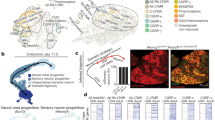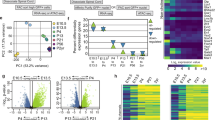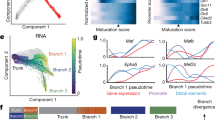Abstract
Developing neurons transiently express somatostatin and its receptors1,2,3, but little is known about their function at these early stages. As we thought that endogenous somatostatin might control the migratory behaviour of immature neurons, we have examined the effects of somatostatin in cerebellar granule cells of early postnatal mice, because these cells express all five types of somatostatin receptors before the initiation of their migration4,5. Here we show that somatostatin has opposite and stage-specific effects on the migration of cerebellar granule cells. Activation of somatostatin receptors increases the rate of granule cell migration near their birthplace, but decreases the rate near their final destination. Furthermore, somatostatin enhances the size and frequency of spontaneous Ca2+ fluctuations in the early phase of migration, whereas it eliminates spike-like Ca2+ transients in the late phase. Somatostatin-induced changes at both early and late phases are reversed by a blockade of K+ channel activity. These results indicate that somatostatin may provide an essential cue for accelerating the movement of granule cells in the early phase and for terminating the movement in the late phase through altering intracellular Ca2+ concentrations and K+ channel activity.
This is a preview of subscription content, access via your institution
Access options
Subscribe to this journal
Receive 51 print issues and online access
$199.00 per year
only $3.90 per issue
Buy this article
- Purchase on Springer Link
- Instant access to full article PDF
Prices may be subject to local taxes which are calculated during checkout




Similar content being viewed by others
References
Gonzalez, B. J. et al. Transient expression of somatostatin receptors in the rat cerebellum during development. Dev. Brain Res. 40, 154–157 (1988).
Inagaki, S. et al. In situ hybridization analysis of the somatostatin-containing neuron system in developing cerebellum of rats. Mol. Brain Res. 6, 289–295 (1989).
Maubert, E. et al. Developmental patterns of somatostatin-receptors and somatostatin-immunoreactivity during early neurogenesis in the rat. Neuroscience 62, 317–325 (1994).
Thoss, V. S., Duc, D. & Hoyer, D. Somatostatin receptors in the developing rat brain. Eur. J. Pharmacol. 297, 145–155 (1996).
Viollet, C. et al. Differential expression of multiple somatostatin receptors in the rat cerebellum during development. J. Neurochem. 68, 2263–2272 (1997).
Schinder, M., Humphrey, P. P. A. & Emson, P. C. Somatostatin receptors in the central nervous system. Prog. Neurobiol. 50, 9–47 (1996).
Villar, M. J., Hokfelt, T. & Brown, J. C. Somatostatin expression in the cerebellar cortex during postnatal development. Anat. Embryol. 179, 257–267 (1989).
Komuro, H. & Rakic, P. Dynamics of granule cell migration: A confocal microscopic study in acute cerebellar slice preparations. J. Neurosci. 15, 1110–1120 (1995).
Komuro, H. & Rakic, P. Distinct modes of neuronal migration in different domains of developing cerebellar cortex. J. Neurosci. 18, 1478–1490 (1998).
Komuro, H., Yacubova, E., Yacubova, E. & Rakic, P. Mode and tempo of tangential cell migration in the cerebellar external granular layer. J. Neurosci. 21, 527–540 (2001).
Baumbach, W. R. et al. A linear hexapeptide somatostatin antagonist blocks somatostatin activity in vitro and influences growth hormone release in rats. Mol. Pharmacol. 54, 864–873 (1998).
Nagata, I. & Nakatsuji, N. Granule cell behavior on laminin in cerebellar microexplant cultures. Dev. Brain Res. 52, 63–73 (1990).
Komuro, H. & Rakic, P. Intracellular Ca2+ fluctuations modulate the rate of neuronal migration. Neuron 17, 275–285 (1996).
Miale, I. L. & Sidman, R. L. An autoradiographic analysis of histogenesis in the mouse cerebellum. Exp. Neurol. 4, 277–296 (1961).
Kuhar, S. G. et al. Changing patterns of gene expression define four stages of cerebellar granule neuron differentiation. Development 117, 97–104 (1993).
Reisine, T. & Bell, G. I. Molecular biology of somatostatin receptors. Endocr. Rev. 16, 427–442 (1995).
Patel, Y. C. Molecular pharmacology of somatostatin receptor subtypes. J. Endocrinol. Invest. 20, 348–367 (1997).
Ikeda, S. R. & Schofield, G. G. Somatostatin blocks a calcium current in rat sympathetic ganglion neuron. J. Physiol. (Lond.) 409, 221–240 (1989).
Gonzalez, B. J. et al. Somatostatin receptors are expressed by immature cerebellar granule cells: Evidence for a direct inhibitory effect of somatostatin on neuroblast activity. Proc. Natl Acad. Sci. USA 89, 9627–9631 (1992).
Komuro, H. & Rakic, P. Selective role of N-type calcium channels in neuronal migration. Science 257, 806–809 (1992).
Komuro, H. & Rakic, P. Modulation of neuronal migration by NMDA receptors. Science 260, 95–97 (1993).
Sims, S. M., Lussier, B. T. & Kraicer, J. Somatostatin activates an inwardly rectifying K+ conductance in freshly dispersed rat somatotrops. J. Physiol. (Lond.) 441, 615–637 (1991).
Hendriks, R., Morest, D. K. & Kaczmarek, L. K. Role of neuronal cell migration for high-threshold potassium currents in the chicken hindbrain. J. Neurosci. Res. 58, 805–814 (1999).
Shibata, R. et al. A-type K+ current mediated by the Kv4 channel regulates the generation of action potential in developing cerebellar granule cells. J. Neurosci. 20, 4145–4155 (2000).
D'Angelo, E., De Filippi, G., Rossi, P. & Taglietti, V. Synaptic activation of Ca2+ action potentials in immature rat cerebellar granule cells in situ. J. Neurophysiol. 78, 1631–1642 (1997).
Bologna, E. & Leroux, P. Identification of multiple somatostatin receptors in the rat somatosensory cortex during development. J. Comp. Neurol. 420, 466–480 (2000).
Taniwaki, T. & Schwartz, J. P. Somatostatin enhances neurofilament expression and neurite outgrowth in cultured rat cerebellar granule cells. Dev. Brain Res. 88, 109–116 (1995).
Rhie, D.-J. et al. Somatostatin potentiates voltage-dependent K+ and Ca2+ channels expression induced by nerve growth factor in PC12 cells. Dev. Brain Res. 112, 267–274 (1999).
Acknowledgements
We thank K. Wikler, M. Perin and P. Rakic for critically reading the manuscript. We also thank E. Yacubova and J. Neffenger for technical help and manuscript preparation. This work was supported by the Cleveland Clinic Foundation (H.K).
Author information
Authors and Affiliations
Ethics declarations
Competing interests
The authors declare no competing financial interests.
Rights and permissions
About this article
Cite this article
Yacubova, E., Komuro, H. Stage-specific control of neuronal migration by somatostatin. Nature 415, 77–81 (2002). https://doi.org/10.1038/415077a
Received:
Accepted:
Issue Date:
DOI: https://doi.org/10.1038/415077a
This article is cited by
-
Moving into shape: cell migration during the development and histogenesis of the cerebellum
Histochemistry and Cell Biology (2018)
-
Migration of Interneuron Precursors in the Nascent Cerebellar Cortex
The Cerebellum (2018)
-
Radial and tangential migration of telencephalic somatostatin neurons originated from the mouse diagonal area
Brain Structure and Function (2016)
-
Neuregulin1/ErbB4-induced migration in ST14A striatal progenitors: calcium-dependent mechanisms and modulation by NMDA receptor activation
BMC Neuroscience (2011)
-
Role of PACAP in Controlling Granule Cell Migration
The Cerebellum (2009)
Comments
By submitting a comment you agree to abide by our Terms and Community Guidelines. If you find something abusive or that does not comply with our terms or guidelines please flag it as inappropriate.



